Traditionally, in our area, it is customary to plant beds horizontally and observe how plants creep in the garden. At the same time, for a vegetable such as a cucumber, the trellis method is excellent, which allows you to successfully grow large and early crops in small areas.
Tapestry is an artificial support for lashes of a cucumber, around which it can twist and grow vertically, receiving the maximum necessary solar energy and the minimum risk of diseases from pests from the soil. You can create such a design in various ways, using improvised materials or special grids for trellis. Suitable wooden bars, metal, polymer pipes and gratings. You can use any materials that can be found in the country.
Content
Advantages and disadvantages of the trellis method of growing cucumbers
The popularity of this method of growing green vegetables is associated with its advantages:
- The bushes are evenly lit throughout the daylight hours, which contributes to the development of fruits on each lash along its entire length.
- Good illumination of the bush allows you to get more yield, because in bright light female flowers are mostly tied.
- Reducing the risk of fungal diseases that destroy plants.
- Thanks to this placement, the culture develops faster, which ultimately leads to an approximation of the harvest time.
- Ergonomic use of the land, which is important both for summer residents and when growing vegetables for sale.
- During irrigation, the liquid flows smoothly from the leaves, preventing the bushes from getting leaf burns on sunny days.
- Convenience in caring for the bushes and during the collection of fruits, since their visibility is many times better than in a regular garden.
- In the process of collecting cucumbers, there is minimal damage to the integrity of the stem and leaves of the plant.
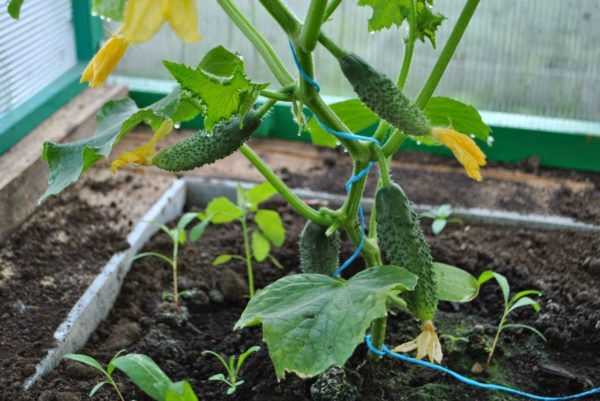 You may be interested in:
You may be interested in:Of the minuses of this method, we can single out the need for additional watering during the growth and ripening of vegetables due to their specific position, as well as the need to make more fertilizers. Since the bushes are arranged vertically, they require 20-30% more fertilizing than with a horizontal crop.
The technique of growing cucumbers on trellis in open ground
Many gardeners use this technique to produce abundant crops. Tapestry technology is quite simple, but requires some basic knowledge.
Varieties of trellis and their manufacture
For the vertical method, several types of materials are used to create the trellis:
- twine;
- plastic or metal mesh;
- twine;
- corners made of metal;
- arcs of metal and polymers.
These materials are used to create a simple structure that allows you to grow cucumbers in an upright position. In shape, such structures can be rectangular, wall, round and in the form of a hut.
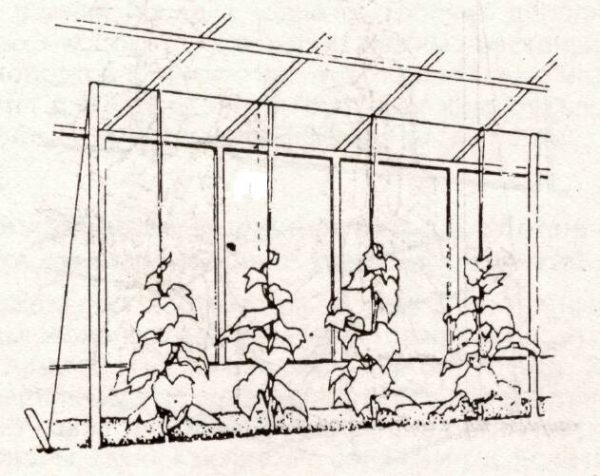
To create a rectangular version, it is necessary to prepare supports with a diameter of 5 cm and more, up to 3 m high. Place them along the proposed bed every 2 m and connect them with a horizontal mount on top. Twine is attached on top of the crossbar, and below it is dug into the ground. This is a very simple way to create a trellis that everyone can do.
To install a wall trellis, you will need to pull a twine or mesh, securing them to the wall of the shed, house or fence. This method of growing can carry an additional aesthetic function, decorating old hedges or unsightly surfaces of utility rooms on the site.
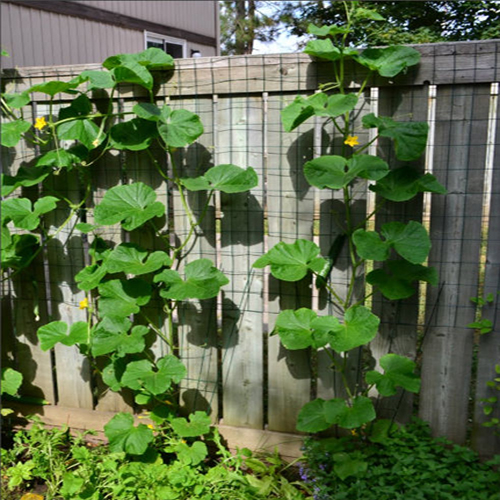
The round and hut structures of the trellis require construction skills and additional materials for manufacturing. For example, a shelter trellis can be built from a polymer net stretched over a square or rectangular wooden frame. Two such squares are set by the "house" and fastened at the top. The lower part is fixed in the soil. Bushes of cucumbers planted under the lower support, and the lashes stretch up the grid.
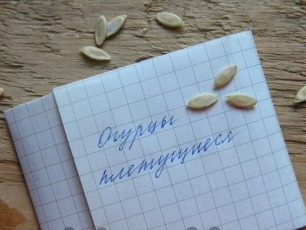 You may be interested in:
You may be interested in:Seed and soil preparation
When planning planting cucumbers on a trellis, soil preparation should be carried out in the autumn months. Dig the site and level it so that water does not collect. Apply fertilizer consisting of manure, superphosphate and ash. For each square meter, 5 kg of manure is needed, approximately 30 and 200 grams of other components, respectively. It will not be amiss to disinfect the soil in the spring immediately before planting, using a solution of potassium permanganate.
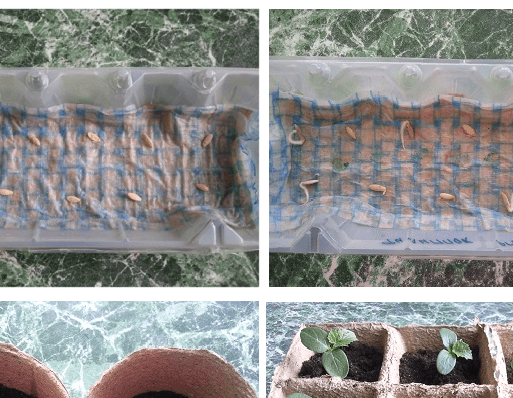
To plant seeds immediately in the ground, you need to prepare them as follows:
- Select suitable for planting by placing the seeds for 10-15 minutes in a solution of salt, the floated to the surface must be discarded.
- Warm cucumber seeds at a temperature of 25-28 degrees on any heating device for several weeks.
- Disinfect them in a solution of potassium permanganate for 15 minutes and rinse in clean water.
- Place in any nutrient fluid for 12 hours, then leave them to swell in a damp cloth, which is well ventilated, for 24 hours at a temperature of at least 25 degrees.
- The last preparatory procedure will be cooling the seeds in the refrigerator for 12-24 hours - for hardening.
These procedures will help to grow actively fruiting bushes of cucumbers, not susceptible to various diseases. When buying hybrid varieties that have already been treated with chemicals in the store, you only need to germinate the seeds before planting.
Landing patterns
Cucumbers can be placed along the trellis in one or two rows. A single-row scheme involves:
- the distance between plants in a row of 15-20 cm;
- rows are located at a distance of 80-110 cm from each other. The minimum distance is more suitable for self-pollinated varieties.
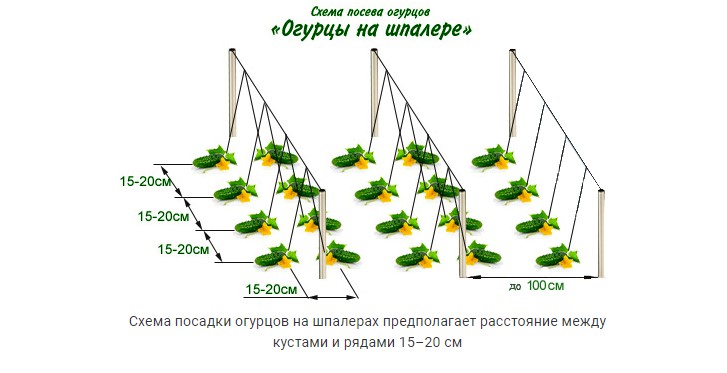
In a two-row scheme, parallel rows are located at a distance of 30-50 cm, and between pairs of rows should be at least 80 cm.
Using such proven planting schemes allows you to care for the bushes without damaging them. In addition, a sufficient distance between plantings allows the lashes to develop well, and reduces the likelihood of developing a fungus infection.
Top dressing
It is recommended to fertilize 4 times per season, taking into account the fertility of the soil, climatic features. Organic and mineral fertilizers, which can be bought in stores, and mixtures prepared independently, are suitable for feeding cucumbers.
Feeding consists of 4 stages:
- After planting, the use of any type of manure or infusion of green grass is recommended. Of mineral fertilizers, it is permissible to use nitrate, potassium salt, superphosphate.
- As soon as the first flowers appeared, you need to apply fertilizer under the root, or spray the bushes. Universal options will be ash and superphosphate for radical top dressing, sugar and boric acid for spraying.
- During the ripening period of most vegetables on the bushes, you can use both organic and mineral fertilizers, at your discretion.
- To prolong the growing season, it is good to use organics, for example, a urea solution at the rate of 15 g per 10 liters of water.
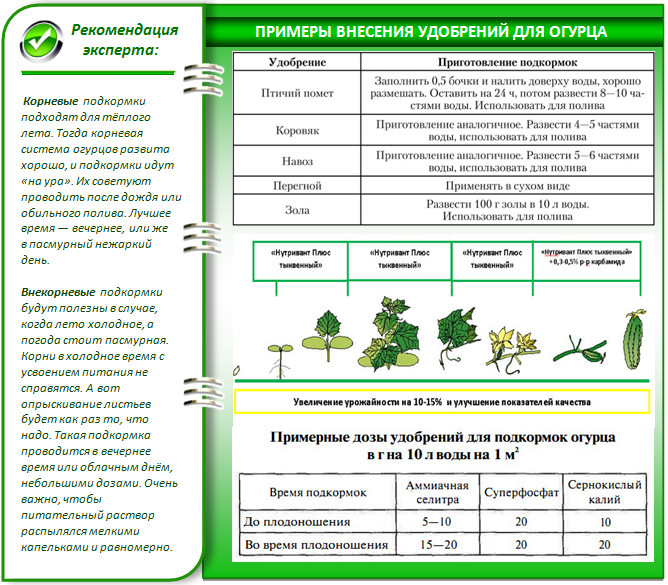
If cucumbers are planted on fertile soil, then only two top dressings can be used: after planting and to increase the growing season.
Scourge and Garter
The formation of the bush should begin after it has grown to a height of 20 cm. This process consists of pinching and garter. It is necessary to create conditions for the main stem to gain strength and be able to bear fruit for a long time. To do this, remove leaves on the side shoots, leaving 2-3 leaves. It is also necessary to wrap the stem around the twine several times a week so that it does not break under the weight of the fruit.
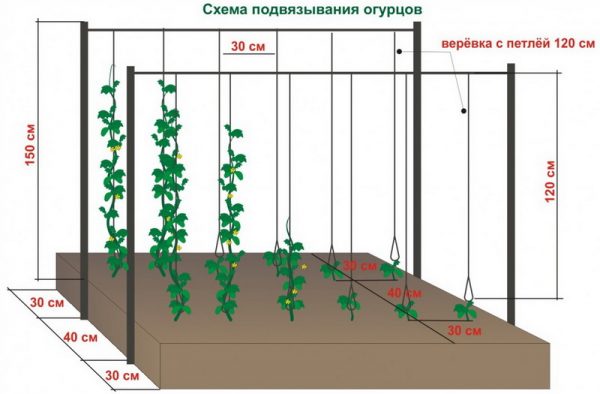
A soft rope should be used for garter, but at the same time it should be strong and elastic so as not to pinch the plants. The rope is attached a few centimeters to the top of the bush, as the cucumber grows, the procedure must be repeated, on average, every 4 days during the period of active growth.
Rules for the care of cucumbers on trellis
If you follow the simple rules for caring for a green vegetable, you can get a rich harvest, with a minimum of effort:
- abundant root watering every 3 days; in the heat, the interval can be reduced to 2 days;
- mulching the soil to avoid overheating of the roots, dry grass is good for this;
- timely application of fertilizers corresponding to the period of bush development;
- Mandatory pruning of the bush for maximum yield.
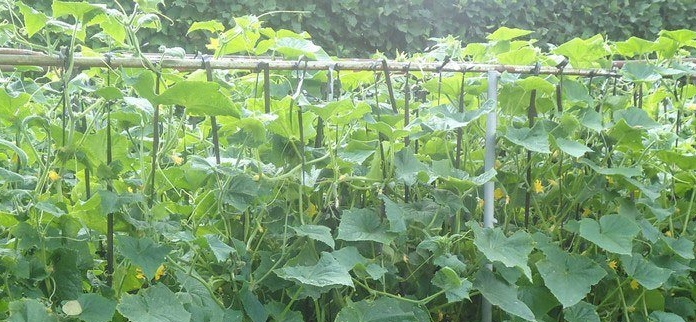
Harvesting seeds and harvesting trellis cucumbers
It should be noted that when using the trellis method for planting soil varieties, you can independently collect seeds for next year, but for this you will have to sacrifice one of the bushes. Ripening a vegetable into seeds is a long process and it stops the formation of ovaries and the ripening of other vegetables on the bush. To obtain seeds, it is enough to leave 1-2 cucumbers and wait until they ripen and turn yellow, after which they can be plucked and seeds can be taken out.
It is necessary to determine the required size of cucumbers, which the gardener focuses on when collecting them: the length can be from 5 to 15 cm, depending on the variety and how it is planned to use vegetables.
It is very important to pluck not only good fruits, but also damaged, irregular, yellowed ones. Thus, the development of diseases in plants is prevented and the bush continues to grow and bear fruit further. Since the trellis makes it possible to pluck cucumbers without unnecessary inclinations, looking for them in thorny bushes, you should be careful to make such a collection and not damage the stems.
How to plant trellis cucumbers in a greenhouse?
You should pay attention to the fact that when using the method of growing vegetables in the greenhouse under consideration, the principle of plant care will not differ much from that which is acceptable for open ground.
Soil and seed preparation
The substrate, which changes annually in the greenhouse, must be adapted for planting cucumbers. The vegetable will develop well in turf soil with the addition of peat. A month before the alleged planting of cucumbers, the soil should be dug up and fertilized, as well as creating beds with furrows for irrigation.
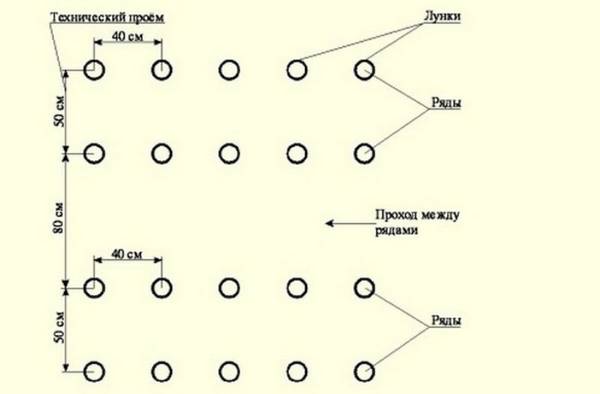
To prepare the seeds for life in the greenhouse, calibrate them and place in a shallow container. At the bottom of such a vessel, gauze or cloth is placed and a little water is poured, seeds are laid out on top. You should put the container in a warm place and wait until the seeds germinate.
Tapestry Making
In a greenhouse, it is quite simple to create a square trellis by placing the supports around the perimeter and securing them 30-40 cm in depth. A distance of 3-4 m between the columns is acceptable. A strong metal wire is well suited for the upper joints of such supports.
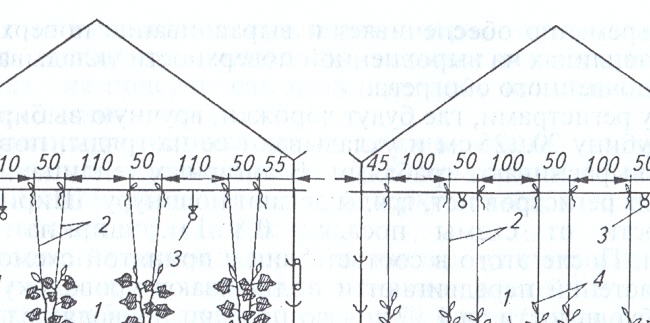
The fastening for bushes can be created using a grid or just pull the twine from the bottom up, using supports and beams that are included in the design of the room itself.
Garter
To fix the bush on the trellis using twine loops, which is fixed at the upper lash. Such loops should be made at the level of 2-3 plant leaves and from time to time, adjust the location of the bush so that the loops do not tighten too tight and do not pinch the stem.
Care
For watering in a greenhouse, you need to use water at a temperature of 22 degrees, irrigation should be done in special holes in the afternoon. As the fruits grow, they should be plucked so that the plant has the strength to form a new ovary. Excess foliage should also be cut off in a timely manner so that it does not take power from the stem. In the warm season, it is necessary to ventilate the greenhouse with cucumbers to avoid overheating of plants.
Possible mistakes when growing
Novice gardeners often make standard mistakes in the process of growing bushes on trellises:
- installing a permanent structure and planting cucumbers in one place for several years in a row, which leads to a decrease in yield;
- placing cucumbers in poorly lit places, which does not allow the photophilous plant to fully develop;
- the use of metal surfaces for trellis in open ground, which leads to overheating of the bush and death of the plant when the metal is glowing in the heat;
- untimely harvesting, which causes the absence of a new ovary and early termination of fruiting.
Common questions
The espalier method of growing cucumbers is popular among gardeners due to the simplicity of caring for plants and the ease of harvesting mature vegetables. Its advantage also lies in the fact that the number of crops increases, and the infection of the culture with diseases becomes unlikely.

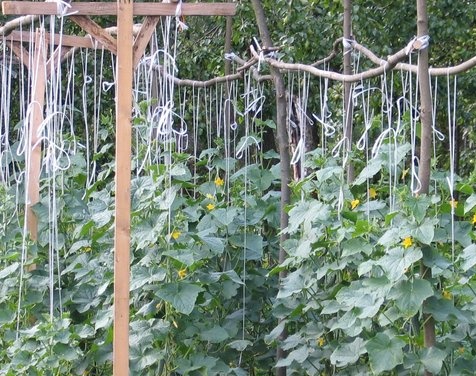
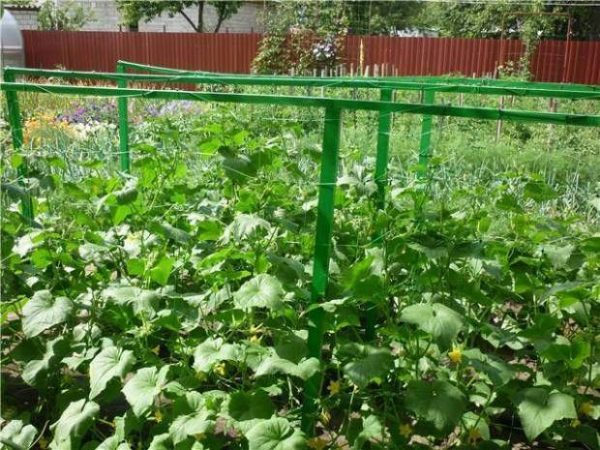
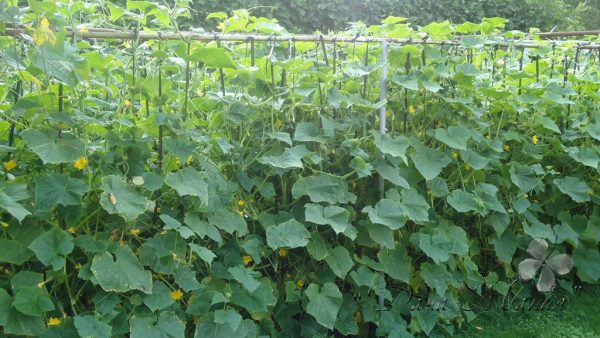



 Armenian cucumber with melon flavor: description and characteristics, reviews
Armenian cucumber with melon flavor: description and characteristics, reviews Do-it-yourself vertical beds for cucumbers: schemes, photos
Do-it-yourself vertical beds for cucumbers: schemes, photos Hollow cucumbers: reasons for the appearance of hollow, what to do
Hollow cucumbers: reasons for the appearance of hollow, what to do Which manure is best for cucumbers: application, how to breed
Which manure is best for cucumbers: application, how to breed